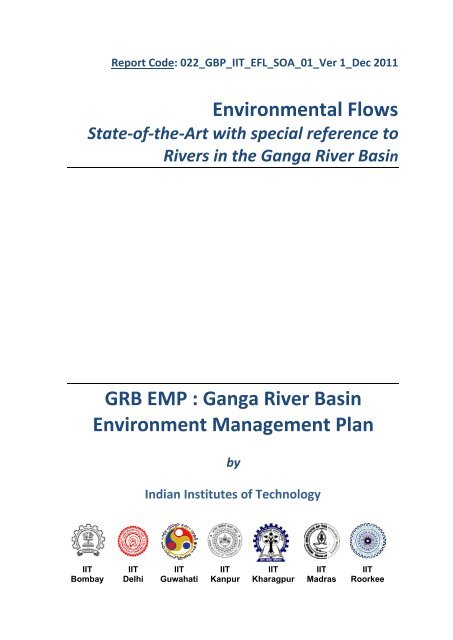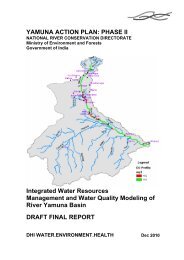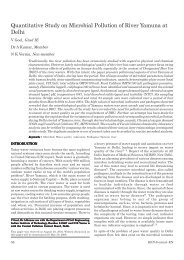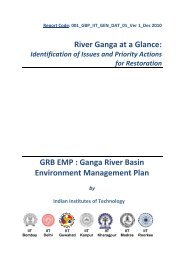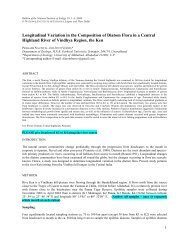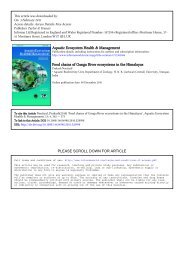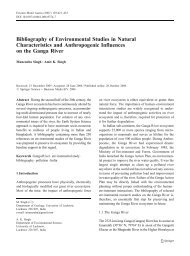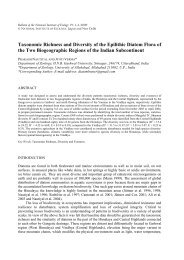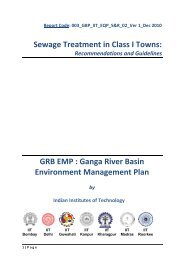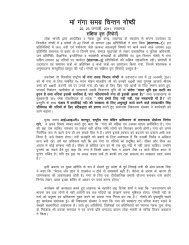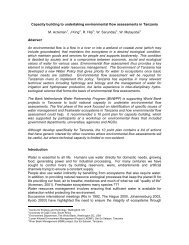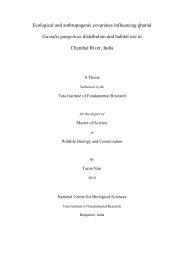download - GANGAPEDIA
download - GANGAPEDIA
download - GANGAPEDIA
Create successful ePaper yourself
Turn your PDF publications into a flip-book with our unique Google optimized e-Paper software.
Report Code Code: 022_GBP_IIT_EFL_SOA_01_Ver _SOA_01_Ver 1_ 1_Dec 2011<br />
State-of-the the-Art Art with special reference to<br />
Rivers in the Ganga River Basi Basin<br />
IIT<br />
Bombay<br />
GRB EMP : Ganga River Basin<br />
Environment Management Plan<br />
Indian Institutes of Technology<br />
IIT IIT<br />
Delhi Guwahati<br />
Environmental Flows<br />
by<br />
IIT<br />
Kanpur<br />
IIT<br />
Kharagpur<br />
IIT<br />
Madras<br />
IIT<br />
Roorkee
2 | P a g e<br />
Report Code: 022_GBP_IIT_EFL_SOA_01_Ver 1_June 2011
3 | P a g e<br />
Preface<br />
Report Code: 022_GBP_IIT_EFL_SOA_01_Ver 1_June 2011<br />
In exercise of the powers conferred by sub-sections (1) and (3) of Section 3 of the<br />
Environment (Protection) Act, 1986 (29 of 1986), the Central Government has<br />
constituted National Ganga River Basin Authority (NGRBA) as a planning, financing,<br />
monitoring and coordinating authority for strengthening the collective efforts of the<br />
Central and State Government for effective abatement of pollution and conservation of<br />
the river Ganga. One of the important functions of the NGRBA is to prepare and<br />
implement a Ganga River Basin: Environment Management Plan (GRB EMP).<br />
A Consortium of 7 Indian Institute of Technology (IIT) has been given the responsibility<br />
of preparing Ganga River Basin: Environment Management Plan (GRB EMP) by the<br />
Ministry of Environment and Forests (MoEF), GOI, New Delhi. Memorandum of<br />
Agreement (MoA) has been signed between 7 IITs (Bombay, Delhi, Guwahati, Kanpur,<br />
Kharagpur, Madras and Roorkee) and MoEF for this purpose on July 6, 2010.<br />
Estimates on Environmental Flows or simply E-Flows are a critical input in preparation of<br />
the GRB EMP. Not much work has been done on E-Flows in Indian rivers, particularly the<br />
rivers in the Ganga Basin. Also, E-Flows assessment is both a social and a scientific<br />
process requiring expert knowledge of various fields including, but not limited to<br />
hydrology, hydraulics, geomorphology, ecology and biodiversity, socio-cultural,<br />
livelihood, and water quality and pollution. Keeping this in view, IIT Consortia has<br />
constituted an E-Flows Group with experts within and outside the IIT system.<br />
This report is one of the many reports prepared by IITs to describe the strategy,<br />
information, methodology, analysis and suggestions and recommendations in<br />
developing Ganga River Basin: Environment Management Plan (GRB EMP). The overall<br />
Frame Work for documentation of GRBMP and Indexing of Reports is presented on the<br />
inside cover page.<br />
Many of the E-Flows group members participated in a two year long study on estimation<br />
of E-Flows in selected stretch of the river Ganga sponsored by WWF – India as part of<br />
Living Ganga Project. This study provided opportunity for experts within and outside<br />
India to exchange knowledge and experience on the subject and help in selection and<br />
adoption of an appropriate methodology. This report heavily draws from the knowledge<br />
gained from such pioneering multi-institutional and interdisciplinary study. Many people<br />
contributed to the preparation of this report directly or indirectly. A list of persons who<br />
have contributed directly and names of those who have taken lead in preparing this<br />
report is given on the reverse side.<br />
Dr Vinod Tare<br />
Professor and Coordinator<br />
Development of GRB EMP<br />
IIT Kanpur
4 | P a g e<br />
The Team<br />
Report Code: 022_GBP_IIT_EFL_SOA_01_Ver 1_June 2011<br />
1. A K Gosain, IIT Delhi gosain@civil.iitd.ac.in<br />
2. B S Murthy, IIT Madras bsm@iitm.ac.in<br />
3. M D Behara, IIT Kharagpur mdbehera@coral.iitkgp.ernet.in<br />
4. N Balaji, IIT Madras nbalaji@iitm.ac.in<br />
5. Nitin Kaushal, WWF-India, Delhi nkaushal@wwfindia.net<br />
6. P M Prasad, IIT Kanpur pmprasad@iitk.ac.in<br />
7. Paritosh Tyagi, Formet Chairman, CPCB Delhi paritoshtyagi@gmail.com<br />
8. R H Sidduqui, NGRBA Expert Member rashidsiddiqi202@hotmail.com<br />
9. R P Mathur, IIT Kanpur rpm_2k1@yahoo.com<br />
10. Rajiv Sinha, IIT Kanpur rsinha@iitk.ac.in<br />
11. Ravi Chopra, NGRBA Expert Member psiddoon@gmail.com<br />
12. Ravindra Kumar, SWaRA-UP ravindra53@yahoo.co.in<br />
13. S K Jain, IIT Roorkee jainsfwt@iitr.ernet.in<br />
14. Sandeep Behera, WWF-India, Delhi sbehera@wwfindia.net<br />
15. Shivam Tripathi, IIT Kanpur shiva@iitk.ac.in<br />
16. Shyam Asolekar, IIT Bombay asolekar@iitb.ac.in<br />
17. Vikrant Jain, Delhi University vjain@geology.du.ac.in<br />
18. Vinod Tare, IIT Kanpur vinod@iitk.ac.in<br />
1. Nitin Kaushal, WWF-India<br />
2. Vinod Tare, IIT Kanpur<br />
Lead Persons
5 | P a g e<br />
Contents<br />
Report Code: 022_GBP_IIT_EFL_SOA_01_Ver 1_June 2011<br />
S No. Page No.<br />
1 Introduction 7<br />
2 Environmental Flows – The Concept and its Rationale 8<br />
3 Overview of E-Flows Estimation Methods 9<br />
4 Comparative Analysis of various Holistic Methodologies for Assessment of<br />
E-Flows 14<br />
5 Importance of E-Flows Assessment for Rivers in the Ganga Basin 20<br />
6 Review of Information Available on E-Flows Estimation on Rivers in Ganga<br />
Basin 21<br />
7 Concluding Remarks 28<br />
8 References 28<br />
9 Appendix I 32
6 | P a g e<br />
Report Code: 022_GBP_IIT_EFL_SOA_01_Ver 1_June 2011
7 | P a g e<br />
Report Code: 022_GBP_IIT_EFL_SOA_01_Ver 1_June 2011<br />
1. Introduction<br />
The modern governance of river basins has shifted towards “Integrated River Basin<br />
Management (IRBM)”—an approach that looks at both water and land management to<br />
ensure that river systems can be used and developed in a sustainable manner. A critical<br />
part of this approach is the assessment and maintenance of Environmental Flows –<br />
‘sufficient water to sustain the integrity and functioning of aquatic ecosystems and the<br />
associated socio-economic and cultural functions’ (UN, 2005).<br />
It is becoming increasingly evident that on regional and global scales, freshwater<br />
biodiversity is more severely endangered than that of terrestrial or marine systems<br />
(O’Keeffe and Le Quesne, 2009). Freshwater systems are home to 40% of all fish species<br />
in less than 0.01% of the world’s total surface water, and when water-associated<br />
amphibians, reptiles and mammals are added to the fish totals, they together account<br />
for as much as one third of global vertebrate biodiversity (O’Keeffe and Le Quesne,<br />
2009). Even at a conservative estimate, there have been global population declines of<br />
freshwater vertebrates averaging 55% between 1970 and 2000 (O’Keeffe and Le<br />
Quesne, 2009).<br />
The best recent examples of good legislation about consideration of Environmental<br />
Flows are from Australia and South Africa. In South Africa, Environmental Flows (called<br />
“ecological reserve”) have the priority over other water users (Smakhtin, 2004).<br />
Flows – the main driver of biodiversity in rivers<br />
Most rivers around the world are highly variable and unpredictable; animals and plants<br />
species that live in them have adapted to sudden extremes such as floods and droughts.<br />
As a result, most river ecologists agree that the communities of animals and plants<br />
found in riverine ecosystems are largely controlled by physical rather than biological<br />
processes (O’Keeffe and Le Quesne, 2009). Thus to maintain freshwater biodiversity, it is<br />
necessary to manage the physical and physicochemical processes in rivers. These<br />
processes mainly influence water quality, sediment dynamics, and, of course, flow. Flow<br />
is the main driver of biodiversity in rivers – it creates the aquatic habitats, brings the<br />
food down from upstream, covers the floodplain with water during high flows, and<br />
flushes the sediment and poor quality water through the system (O’Keeffe and Le<br />
Quesne, 2009).<br />
A recent World Bank document (World Bank, 2008) states that river scientists refer to<br />
the flow regime in freshwater systems as a “Master Variable” due to the strong<br />
influence it has on the other key environmental factors (water chemistry, physical<br />
habitat, biological composition, and interactions). During recent decades, scientists have<br />
amassed considerable evidence that a river’s flow regime – its variable pattern of high<br />
and low flows throughout the year, as well as variation across many years – exerts great<br />
influence on river ecosystems. Each component of a flow regime – ranging from low<br />
flows to floods – plays an important role in shaping a river ecosystem.
8 | P a g e<br />
Report Code: 022_GBP_IIT_EFL_SOA_01_Ver 1_June 2011<br />
2. Environmental Flows – The Concept and its Rationale<br />
Recognition of the escalating hydrological alterations of rivers on a global scale and<br />
resultant environmental degradation, has led to the establishment of the science of<br />
Environmental Flows (E-Flows) Assessment, whereby the quantity and quality of water<br />
required for ecosystem conservation and resources protection are determined. Several<br />
attempts have been made to define E-Flows in rivers.<br />
The 3 rd World Water Forum held at Kyoto in 2003 defined E-Flows as the provision of<br />
water within rivers and ground water systems to maintain downstream ecosystems and<br />
their benefits, where the river and underground system is subject to competitive uses<br />
and flow regulations. The E-Flows are thus considered as an amount of water that is<br />
kept flowing down a river in order to maintain the river in a desired environmental<br />
condition. All of the elements of a natural flow regime, including floods and droughts,<br />
are important in controlling the characteristics and natural communities in a river.<br />
The IUCN (2003) defines “E-Flows as the water regime provided within a river, wetland<br />
or coastal zone to maintain ecosystems and their benefits where there are competing<br />
water uses and where flows are regulated”. The IUCN makes a clear conceptual<br />
distinction between the water needed to maintain the ecosystem in near pristine<br />
condition, and that which is eventually allocated to it, following a process of a holistic<br />
assessment for E-Flows.<br />
Section 5.2.5 of National Environment Policy (2006) of India on ‘Freshwater Resources’<br />
calls for promotion of ‘integrated approaches to management of river basins by the<br />
concerned river authorities, considering upstream and downstream inflows and<br />
withdrawals by season, interface between land and water, pollution loads and natural<br />
regeneration capacities, to ensure maintenance of adequate flows, in particular for<br />
maintenance of in-stream ecological values, and adherence to water quality standards<br />
throughout their course in all seasons’. This typically sets attributes for defining E-Flows.<br />
Brisbane Declaration (2007) defines E-Flows as the quantity, timing, and quality of water<br />
flows required to sustain freshwater and estuarine ecosystems and the human<br />
livelihoods and well-being that depend on these ecosystems.<br />
After critical study of various definitions of E-Flows, the consortia of 7 IITs for<br />
preparation of Ganga River Basin Management Plan (GRBMP) concludes that<br />
environmental flows refer to a regime of flows that mimics the natural pattern of a<br />
river’s flow, so that the river can perform its natural functions such as transporting<br />
water and solids from its catchment, formation of land, self-purification and sustenance<br />
of its myriad systems along with sustaining cultural, spiritual and livelihood activities of<br />
the people or associated population. Considering this following definition for E Flows is<br />
considered most appropriate and is being adopted.
3. Overview of E-Flows Estimation Methods<br />
9 | P a g e<br />
Report Code: 022_GBP_IIT_EFL_SOA_01_Ver 1_June 2011<br />
"Environmental Flows are a regime of flow in a river or stream that describes the<br />
temporal and spatial variation in quantity and quality of water required for<br />
freshwater as well as estuarine systems to perform their natural ecological<br />
functions (including sediment transport) and support the spiritual, cultural and<br />
livelihood activities that depend on these ecosystems"<br />
From global experience, the assessment and establishment of E-Flows has significantly<br />
contributed to the management of natural resources in a judicious manner. O’Keeffe<br />
and Le Quesne (2009) have explained this phenomenon in detail. Some salient points are<br />
reproduced as follows for ready reference.<br />
1. The characteristics and ecosystems of rivers are controlled in a very significant way<br />
by the flows. A good E-Flows regime mimics all flow variations that are needed to<br />
keep the river and all its aspects functioning in a desired condition.<br />
2. E-Flows assessment is both a social and a scientific process. There is no one correct<br />
E-Flows regime for rivers – the answer will depend on what people want from a<br />
river.<br />
3. E-Flows assessment is based on the assumption that there is some ‘spare’ water in<br />
rivers that can be used without unacceptably impacting on the ecosystem and<br />
societal services that the river provides.<br />
4. E-Flows are not just about establishing a ‘minimum’ flow level for rivers; it actually<br />
considers all the elements of a natural flow regime, including floods, diurnal<br />
variations, and droughts, as they are important with respect to silt transport and in<br />
controlling the characteristics and natural communities of a river.<br />
5. E-Flows don’t always require an increase from present flows. In some cases, e.g.<br />
where low season flows have been artificially increased by inter-basin transfers or<br />
releases from dams for hydropower, the E-Flows recommendations may be for lower<br />
flows.<br />
6. E-Flows assessments are also very useful to know the environmental requirements<br />
before any development plans are made, so that these flows can be factored into<br />
the planning process at an early stage.<br />
In order to reach a consensus about E-Flows, people need to have trade-off between<br />
river’s natural functions and river’s uses such as (i) growing more crops using its water,<br />
(ii) generate electricity, (iii) supply towns with water for domestic and municipal<br />
purposes, (iv) national/cultural heritage, e.g. river Ganga in India or river Thames in<br />
England. This guides in deciding the desired state of the river. In most cases people want
10 | P a g e<br />
Report Code: 022_GBP_IIT_EFL_SOA_01_Ver 1_June 2011<br />
to make use of the water and other resources of the river, so they do not want to keep it<br />
entirely natural. Also, in most cases (all cases hopefully) they do not want to turn it into<br />
a dry river bed or a drain for wastes. Thus the decision is to choose the state of the river<br />
somewhere between natural and completely ruined. This is the role of E-Flows<br />
assessment. Further, it is also aimed at keeping at least some of the natural flow<br />
patterns along the whole length of a river, so that the people, animals and plants<br />
downstream can continue to survive and use the river’s resources. This is essential for<br />
sustenance of the river itself as E-Flows are envisaged to sustain various river functions.<br />
Acreman and Dunbar (2004) state that there is no simple figure which can be considered<br />
as E-Flows requirement for a river. It is actually related to number of factors: (i) size of<br />
the river, (ii) river’s natural state, type or perceived sensitivity, and (iii) a combination of<br />
desired state of river and in practice, the uses to which it is put. They have classified the<br />
E-Flows settings into two distinct categories, where one of them is called the ‘Objective<br />
Based Flow-Setting’ and the other one is ‘Scenario Based Flow-Setting’. Both these<br />
categories have merits and limitations. The answer to select the appropriate<br />
methodology lies in the requirements and aspirations of the people from their rivers. O<br />
Keeffe and Le Quesne (2009) also essentially advocate the same concept.<br />
Objective Based Flow-Setting: In certain cases, people intend to have specific predefined<br />
ecological, economical and social objectives for the river. In such situations<br />
objective based flow setting can be adopted. For applying such an approach, the experts<br />
have to build a consensus on desired state of river. An example of such an application is<br />
from central valley of Senegal River basin, where the objective is to spare 50,000<br />
hectares of floodplain for flood recession agriculture. As approximately, half the flooded<br />
area is cultivated, this equates to inundation of 1,00,000 hectares, which require around<br />
7,500 MCM of water to be released from Manantali dam (Acreman, 2003). WWF-India’s<br />
study on Assessment of E-Flows in the Upper Stretch of river Ganga also considered<br />
objective based flow-setting wherein the geomorphologic, ecological, socio-economic<br />
and cultural objectives of the river were first established by the expert groups and then<br />
river flow regime is established using hydraulic and hydrologic modeling to meet these<br />
objectives (WWF-India, 2011).<br />
Scenario Based Flow-Setting: This is basically an alternative to the above one, where the<br />
water managers are able to understand and make decision on water allocations and<br />
scenarios for trade offs in managing and balancing the water demands/requirements.<br />
For instance – Under the Lesotho Highland Water Project, various scenarios of E-Flows<br />
releases from dams were considered. For each scenario, the impacts on the downstream<br />
river ecosystems and dependent livelihoods were determined (King et al., 2003). These<br />
scenarios permitted the Lesotho government to assess the trade-offs presented by<br />
different E-Flows options.
11 | P a g e<br />
Report Code: 022_GBP_IIT_EFL_SOA_01_Ver 1_June 2011<br />
Review of various methodologies developed across the world for<br />
assessment of E-Flows<br />
As stated earlier, E-Flows are required for (i) maintaining river regimes, (ii) self<br />
purification, (iii) maintaining aquatic biodiversity, (iv) groundwater recharge, (v)<br />
supporting livelihoods, and (vi) allowing the river to play its role in cultural and spiritual<br />
lives of people. In all contexts, determining E-Flows should be an adaptive process, in<br />
which flows may be successively modified in the light of increased<br />
knowledge/information, changing priorities, and changes in infrastructure over time.<br />
E-Flows assessment is thus a combination of scientific and social aspects. The scientists<br />
can do the best assessment of flow needs, but it won’t be implemented unless people<br />
know why the flows should be left in the river, and think that it is important to do so.<br />
The E-Flows assessment was developed as an eco-hydrological process in the 1970’s and<br />
80’s. There was a gradual realization in the 1980’s that there needed to be a social<br />
component to the process – that the stakeholders needed to have a say in the uses and<br />
consequent condition of the resource (O’Keeffe, Le Quesne, 2009). But, it wasn’t until<br />
the 1990’s that there has been a full realization that E-Flows assessment is social process<br />
with an eco-hydrological process as an essential ingredient.<br />
As the concept of E-Flows has evolved, there has been significant development of<br />
approaches to the assessment of E-Flows. There is no one correct E-Flows regime for<br />
rivers – the answer will depend on what people want from a river and not just about<br />
establishing a ‘minimum’ flow level for rivers. E-Flows assessments are not just useful on<br />
rivers for which the water resources have been developed – it’s very useful to know the<br />
environmental requirements before any development infrastructure plans are made, so<br />
that these flows can be factored into the planning process at an early stage.<br />
Assessment of E-Flows can be referred as to how much water can be withdrawn from<br />
the river without disturbing essential flow requirements of the river to an extent that,<br />
the specified and valued features of the river and its ecosystem are maintained and not<br />
depleted to significant level.<br />
A global review of E-Flows Assessment methodologies by Tharme (2003) reveals that<br />
there are more than 200 methodologies, some are very quick modeling or extrapolation<br />
methods, requiring no or minimal extra work; others require years of fieldwork and<br />
specialists from a number of disciplines. Various E-Flows assessment methodologies can<br />
be broadly classified into four categories.<br />
Hydrology-based<br />
Hydrology based methods are confined to the use of existing, or modeled flow data, on<br />
the assumption that maintaining some percentage of the natural flow will provide for<br />
the environmental issues of interest.<br />
Hydrology based methodologies constituted the highest proportion of the overall<br />
number of methodologies recorded with a total of over 60 different hydrological indices
12 | P a g e<br />
Report Code: 022_GBP_IIT_EFL_SOA_01_Ver 1_June 2011<br />
or techniques applied till date. Many of such methodologies have become obsolete over<br />
time, due to the fact that they are monotonous and there were no provision to integrate<br />
other associated aspects, for instance – the ecology, biodiversity, etc.<br />
Hydraulic rating<br />
These methods measure changes in the hydraulic habitat available (wetted-perimeter,<br />
depth, velocity, etc.) based on a single cross-section of the river that measures the shape<br />
of the channel. This cross-section is used as a surrogate for biological habitat, and allows<br />
for a rough assessment of changes to that habitat with changing flows.<br />
Of the 23 hydraulic rating methodologies reported representing roughly 11% of the<br />
global total, most of them were developed to recommend in-stream flows for<br />
economically important salmonid fisheries in the United States during 1960s and 70s.<br />
These methodologies have been superseded by sophisticated habitat simulation and<br />
holistic methodologies in the recent years.<br />
Habitat simulation<br />
These are a development of the hydraulic rating methodologies. With these methods,<br />
multiple rated cross-sections are used in a hydraulic model to simulate the conditions in<br />
a river reach, again based on wetted perimeter, and average depth and velocity of flow.<br />
Habitat simulation methodologies ranked second (28%) only to hydrological<br />
methodologies at a global scale. There are about 60 such methodologies recorded<br />
throughout the world. These methodologies are more popular in the United States.<br />
Holistic methodologies<br />
These are based on the use of multiple specialists in different fields to provide a<br />
consensus view of the appropriate flows to meet a pre-defined set of environmental<br />
objectives, or to describe the consequences of different levels of modification to the<br />
flow regime. Most of these methods make use of (i) a hydrologist and a hydraulics<br />
engineer to provide the baseline data on flows and hydraulic conditions, (ii) freshwater<br />
biologists for fish, invertebrates, and riparian vegetation to characterize the<br />
requirements of the biotic communities, (iii) a geomorphologist to predict the changes in<br />
sediment transport and channel maintenance at different flows, (iv) a water quality<br />
specialist, and (v) a socio-economist.<br />
Over the period of time, the primitive methodologies are being replaced by more<br />
comprehensive holistic methodologies in the UK, Australia and South Africa. While<br />
emphasizing the role of multi-disciplinary expert’s team in assessment of E-Flows,<br />
Acreman and Dunbar (2004) pointed out that, in earlier days, the opinion of one expert<br />
was used to assess E-Flows. However, a better alternative that has gradually replaced<br />
earlier methodologies is the use of a multi-disciplinary team, which comes out with E-<br />
Flows recommendations, after much needed deliberations and brainstorming. It is
largely the holistic methodologies which provide the greater opportunity to have a<br />
multidisciplinary team of experts.<br />
The choice of method from the list of various holistic methodologies depends on (a) tthe<br />
urgency of the problem, , (b) rresources<br />
available for the analysis, , (c) tthe<br />
importance of<br />
the river, (d) difficulty ifficulty of implementation<br />
implementation, and (e) the he complexity of the system system.<br />
Acreman and Dunbar (2004) state that no single methodology can be considered as the<br />
best and all the methods would benefit from furthe further r development and refinement.<br />
Moreover, the science of EE-Flows<br />
Flows is still young and much is still to be learnt learnt.<br />
Historically the United States has been at the forefront to develop, experiment and<br />
exercise various methodologies for assessment of EE-Flows.<br />
However, in the recent times,<br />
other countries like Australia, South Africa, China, England, New Zealand, Brazil, Japan,<br />
Portugal, Latin America, Czech Republic Republic, etc. are also involved in E-Flows Flows assessment and<br />
establishment. Geographical distribution of appli application cation of various methodologies is<br />
presented in Figure 1.<br />
13 | P a g e<br />
19%<br />
8%<br />
38%<br />
A: Hydrological Methodology B: Hydraulic Rating<br />
3%<br />
26%<br />
13%<br />
6%<br />
1%<br />
C: Habitat Simulation D: Holistic<br />
North America<br />
Europe and Middle East Africa<br />
Australia<br />
26%<br />
7%<br />
51%<br />
2%<br />
Report Code: 022_GBP_IIT_EFL_SOA_01_Ver 2_GBP_IIT_EFL_SOA_01_Ver 1_June 2011<br />
Figure 1: Geographical Distribution of Application of Various EE-Flows<br />
Flows Estimation<br />
Methodologies<br />
12%<br />
65%<br />
12%<br />
Rest of Asia<br />
6%<br />
76%<br />
29%<br />
Central and South America
S No<br />
14 | P a g e<br />
Report Code: 022_GBP_IIT_EFL_SOA_01_Ver 1_June 2011<br />
A closer analysis of various methodologies for assessment of E-Flows suggests that the<br />
simpler and primitive methodologies including hydrology based, hydraulic rating and<br />
habitat simulation are getting outdated and various holistic methodologies are replacing<br />
them as a comprehensive tool for assessment of E-Flows. An investigation of the<br />
different methodologies involving a team of experts from various<br />
institutes/organizations and with variety of expertise conducted by WWF-India about<br />
three years back suggested that holistic methodologies are most suitable for the rivers<br />
like Ganga. Holistic methods are not only comprehensive, but also allow consideration of<br />
socio-economic and environmental aspects along with scientific and technical aspects.<br />
4. Comparative Analysis of various Holistic Methodologies for<br />
Assessment of E-Flows<br />
Arthington et al. (2004) have given detailed account of various holistic methodologies<br />
developed and being applied across the world. For sake of brevity, an attempt has been<br />
made to present a comparative analysis of various important holistic methodologies in<br />
Table 1. Much of the information given in Table 1 has been adopted from Arthington et<br />
al. (2004).<br />
Table 1: Comparative Assessment of Various Holistic E Flow Estimation Methods<br />
Name of Methodology<br />
and its origin<br />
1 Expert Panel Assessment<br />
Method (EPAM) (Swales<br />
and Harris, 1995).<br />
First multidisciplinary panel<br />
based E-Flows<br />
Methodology developed<br />
and used by Department of<br />
Water Resources &<br />
Fisheries in New South<br />
Wales, Australia.<br />
Features and Strengths Limitations<br />
- Low resource intensive<br />
- Bottom-up, reconnaissance-level<br />
approach<br />
- Rapid, inexpensive and sitespecific<br />
- Requires limited field data<br />
- Suitable for sites where dam<br />
releases are possible<br />
- Aim to address river ecosystem<br />
health<br />
- Relies on field based ecological<br />
interpretations<br />
- Recommendations<br />
purely based on<br />
opinion of experts<br />
and no role of other<br />
stakeholders,<br />
mainly users<br />
- Focused on fish<br />
species<br />
- No explicit<br />
guidelines for<br />
application<br />
- Subjective scoring<br />
approach, so poor<br />
congruence in<br />
opinion of different<br />
panel experts<br />
Table continued to next page … … … …
S No<br />
2<br />
… … … …Table continued from previous page<br />
Name of Methodology<br />
and its origin<br />
Scientific Panel<br />
Assessment Method<br />
(SPAM) (Thoms et al. 1996;<br />
Cottingham et al., 2002)<br />
Developed during E-Flows<br />
assessment for Barwon-<br />
Darwin River system,<br />
Australia<br />
3 Habitat Analysis Method<br />
(Walter et al. 1994; Burgess<br />
and Vanderbyl 1996;<br />
Arthington, 1998)<br />
Developed by former<br />
Queensland’s Dept. of<br />
Primary Industries and<br />
Water Resources (now<br />
called Department of<br />
Natural Resources [DNR])<br />
in Australia, as part of<br />
water allocation and<br />
management planning<br />
initiative.<br />
15 | P a g e<br />
Report Code: 022_GBP_IIT_EFL_SOA_01_Ver 1_June 2011<br />
Features and Strengths Limitations<br />
- Bottom-up, mixed approach i.e.<br />
includes field and desktop<br />
- Evolved from EPAM as more<br />
sophisticated and transparent<br />
expert panel approach<br />
- Considers other biodiversity<br />
actors like – fish, trees, macrophytes,<br />
invertebrates and geomorphology<br />
- Incorporates systemic hydrological<br />
variability and elements of<br />
ecosystem functioning<br />
- Includes stakeholders panel<br />
workshop<br />
- Moderately rapid, flexible and<br />
resource intensive<br />
- Simpler, less rigorous in<br />
compared to DRIFT and BBM<br />
- Relatively rapid and inexpensive<br />
- Basin-wide reconnaissance<br />
method for determining<br />
preliminary E-Flows<br />
requirements at multiple points<br />
in catchment<br />
- Superior to simple hydrological<br />
methodologies<br />
- Bottom-up approach, field data<br />
requirement is limited or absent<br />
- Identifies generic aquatic habitat<br />
types existing in the catchment<br />
- Determines flow related<br />
ecological requirement of each<br />
habitat<br />
- appears limited to<br />
single application in<br />
Australia in its<br />
original form<br />
- Highly generalized<br />
approach<br />
- Requires significant<br />
modifications before<br />
adopting in other<br />
river basins<br />
- Inadequate for<br />
comprehensive E-<br />
Flows assessment<br />
- Little consideration<br />
of specific flow<br />
needs of individual<br />
ecological components<br />
- Requires standardization<br />
of process<br />
- Represents simplified<br />
version of<br />
holistic approach<br />
and largely superseded<br />
by Benchmarking<br />
Methodology<br />
Table continued to next page … … … …
S No<br />
… … … …Table continued from previous page<br />
Name of Methodology<br />
and its origin<br />
4 Benchmarking<br />
Methodology (Brizga et al.<br />
2001, 2002)<br />
Developed in Queensland<br />
by local researchers and<br />
DNR in Australia, to<br />
provide a framework for<br />
assessing risk of<br />
environmental impacts due<br />
to water resources<br />
development at basin level<br />
5 Environmental Flow Management<br />
Plan Method<br />
(FMP) (Muller 1997; DWAF<br />
1999)<br />
Developed in South Africa<br />
by the Institute for Water<br />
Research, for use for<br />
intensively regulated river<br />
systems<br />
16 | P a g e<br />
Report Code: 022_GBP_IIT_EFL_SOA_01_Ver 1_June 2011<br />
Features and Strengths Limitations<br />
- Rigorous and comprehensive<br />
- Scenario based, top-down<br />
approach for application at basin<br />
level<br />
- Uses field and desktop data for<br />
multiple river sites<br />
- Assesses ecological conditions<br />
and trends<br />
- Includes formation of multidisciplinary<br />
expert team and<br />
development of hydrological<br />
model for catchment<br />
- Defines link between flow regime<br />
components and ecological<br />
processes<br />
- Presents a comprehensive<br />
benchmarking process and<br />
transparent reporting system<br />
- Simplified bottom-up approach<br />
- Applicable in highly regulated<br />
and managed river systems with<br />
considerable operational limitations<br />
- Workshop based<br />
- Multidisciplinary assessment including<br />
ecologists and system<br />
operators<br />
- Determines current ecological<br />
status and desired future state<br />
- No explicit consideration<br />
of social<br />
aspects<br />
- Requires evaluation<br />
of several aspects<br />
including –<br />
(i) applicability and<br />
sensitivity of key<br />
flow statistics,<br />
(ii) degree to<br />
which benchmarks<br />
from other basins/<br />
sites within basins<br />
are valid considering<br />
differences<br />
in river hydrology<br />
and biota<br />
- Doesn’t provide the<br />
room to integrate<br />
other local signi-<br />
ficant aspects like<br />
cultural and spiritual<br />
ones<br />
- Limited scope for<br />
applicability as structure<br />
and procedures<br />
for application<br />
are not formalized<br />
and well documented<br />
- No provision of<br />
evaluation, so limited<br />
applicability<br />
- Not replicable as the<br />
methodology is<br />
marred with uncertainties<br />
Table continued to next page … … … …
S No<br />
… … … …Table continued from previous page<br />
Name of Methodology<br />
and its origin<br />
6 Downstream Response to<br />
Imposed Flow Transformations<br />
(DRIFT) (King et<br />
al. 2003; Arthington and<br />
Pusey, 2003)<br />
Developed in South Africa<br />
with inputs from Australian<br />
researchers as an<br />
interactive scenario based<br />
holistic methodology<br />
7 Flow Restoration Methodology<br />
(FLOWRESM):<br />
(Arthington et al. 1999;<br />
Arthington et al. 2000)<br />
Developed in a study of the<br />
Brisbane river in Queensland,<br />
Australia.<br />
17 | P a g e<br />
Report Code: 022_GBP_IIT_EFL_SOA_01_Ver 1_June 2011<br />
Features and Strengths Limitations<br />
- Rigorous, top-down, welldocumented<br />
approach<br />
- Scenario based approach with<br />
interactive scenario development<br />
- Appropriate for comprehensive<br />
exercises for assessment of E-<br />
Flows<br />
- Mix of biophysical, economical<br />
and sociological approach<br />
- High potential for application in<br />
other aquatic ecosystems<br />
- Amendable to simplification for<br />
more rapid assessments<br />
- Suitable for river systems<br />
exhibiting a long history of flow<br />
regulations and requiring flow<br />
restoration<br />
- Preliminary bottom-up, field and<br />
desktop approach<br />
- Emphasize on identification of<br />
the essential features that need<br />
to be built back into the<br />
hydrological regime to shift the<br />
regulated system towards the<br />
pre-regulation state<br />
- More rigorous than expert panel<br />
methods<br />
- Include flexible top-down process<br />
for assessing ecological implications<br />
of alternate modified<br />
flow regimes<br />
- Provides limited<br />
consideration for<br />
synergetic interacttions<br />
among different<br />
ecosystem<br />
components<br />
- Requires significant<br />
documentation of<br />
generic procedures<br />
- Limited inclusion of<br />
flow indices describing<br />
system variability<br />
- Risk of inadvertent<br />
omissions of critical<br />
flow events<br />
- Requires significant<br />
documentation of<br />
generic procedures<br />
- Single application in<br />
Australia till date<br />
Table continued to next page … … … …
S No<br />
… … … …Table continued from previous page<br />
Name of Methodology<br />
and its origin<br />
8 Flow Events Method<br />
(FEM): (Stewardson and<br />
Cottingham, 2002)<br />
Developed in ‘Australian<br />
Cooperative Research<br />
Centre for Catchment<br />
Hydrology’ to provide state<br />
agencies with a standard<br />
approach<br />
9 River Babingley (Wissey)<br />
Method: (Petts et al. 1999)<br />
Developed for application<br />
in groundwater dominated<br />
rivers in Anglian region of<br />
England<br />
18 | P a g e<br />
Report Code: 022_GBP_IIT_EFL_SOA_01_Ver 1_June 2011<br />
Features and Strengths Limitations<br />
- Top-down method for regulated<br />
rivers<br />
- Based on empirical data and<br />
expert judgment<br />
- Integrates existing analytical<br />
techniques and expert opinion to<br />
identify vital aspects of flow<br />
regime<br />
- Assesses ecological impacts of<br />
changes in flow regimes<br />
- Specifies E-Flows rules and<br />
targets<br />
- Optimizes flow management<br />
rules to maximize ecological<br />
benefits within the constraints of<br />
existing WRD schemes<br />
- Bottom-up field and desktop<br />
approach<br />
- Uses hydro-ecological, habitat<br />
and hydrological simulation tools<br />
to assist in identification of E-<br />
Flows<br />
- Allows for flexible examination of<br />
alternate E-Flows scenarios<br />
- Includes provision for both<br />
drought and wet year conditions<br />
- Considers biota<br />
- Limited application<br />
in other river basins,<br />
so far applied in<br />
Australia only<br />
- No consideration of<br />
an associated expert<br />
panel<br />
- loosely structured<br />
approach with<br />
limited explanation<br />
of procedures for<br />
integration of<br />
multidisciplinary<br />
inputs<br />
- Specific to base E-<br />
Flows dominated<br />
rivers<br />
- Requires further<br />
research in intricate<br />
basins<br />
- Wider application is<br />
very limited<br />
Table continued to next page … … … …
S No<br />
… … … …Table continued from previous page<br />
Name of Methodology<br />
and its origin<br />
10 Building Block<br />
Methodology (BBM) (King<br />
and Louw 1998; King et al.<br />
2002)<br />
Developed in South Africa<br />
by local researchers<br />
through applications in<br />
numerous water resources<br />
development projects to<br />
address E-Flows<br />
requirements for entire<br />
riverine ecosystems under<br />
conditions of variable<br />
resources. Adapted for<br />
intermediate and<br />
comprehensive<br />
determinations of the<br />
ecological Reserves under<br />
the new South Africa<br />
Water law.<br />
19 | P a g e<br />
Report Code: 022_GBP_IIT_EFL_SOA_01_Ver 1_June 2011<br />
Features and Strengths Limitations<br />
- Rigorous and extensively<br />
documented<br />
- Manual and case studies<br />
available<br />
- Perspective bottom-up approach<br />
with interactive scenario<br />
development<br />
- Takes account of number of sites<br />
within the critical stretch of the<br />
river<br />
- Well established socio-economic<br />
component<br />
- Flexible to accommodate other<br />
local aspects, like religious and<br />
spiritual requirements (hence<br />
applicable for Indian rivers)<br />
- Functions well in data-rich and<br />
data-poor situations<br />
- Multidisciplinary approach with<br />
continuous deliberations/<br />
workshops among various<br />
experts<br />
- Designed to provide specific predefined<br />
river condition<br />
- High potential for application to<br />
other aquatic ecosystems<br />
- Links to external stakeholders<br />
and public participation<br />
processes<br />
- Less time and cost intensive in<br />
comparison to DRIFT<br />
methodology<br />
- Applicable to regulated and nonregulated<br />
river regimes<br />
- Globally, most frequently used<br />
methodology<br />
- Adopted as a standard<br />
methodology for South African<br />
Reserve determinations<br />
- Moderate to highly<br />
resource intensive<br />
In the recent times, as the science of E-Flows has gained significant impetus, the viability<br />
and acceptability of various methodologies is being contested. Therefore, there has
20 | P a g e<br />
Report Code: 022_GBP_IIT_EFL_SOA_01_Ver 1_June 2011<br />
been changing pattern in the preferences for adoption of methodologies for E-Flows<br />
assessment. As a result of this, the researchers, practitioners, academicians and people<br />
from the civil society has apparent inclination towards various methodologies falling<br />
under the category of ‘holistic’ ones, for the simple reason that, the methodologies<br />
under this category have a comprehensive approach and takes into consideration<br />
various associated aspects of a river regime and not only the hydrology and hydraulics.<br />
In a nutshell, the process of development of various E-Flows assessment methodologies<br />
is an evolutionary one, where a specific methodology takes lesson from previous<br />
methodologies and in the process the methodology under consideration gets refined.<br />
Out of the different holistic methodologies, the E-Flows group constituted by the IIT<br />
Consortia considers Building Block Methodology (BBM) to be one of the most advanced<br />
and refined methodology. Its suitability and applicability with flexibility gives it an edge<br />
over other methodologies. The complexity and interests of multi-stakeholders can be<br />
handled by the BBM in estimation of E-Flows. Further details on BBM are presented in<br />
Appendix I for ready reference.<br />
5. Importance of E-Flows Assessment for Rivers in the<br />
Ganga Basin<br />
The spiritual significance of most rivers in the Ganga basin is well known and beyond any<br />
doubt. Imperial Gazetteer of India described the Ganga saying: “There is not a river in<br />
the world which has influenced humanity or contributed to the growth of material<br />
civilization, or of social ethics, to such an extent as the Ganges. The wealth of India has<br />
been concentrated on its valley, and beneath the shade of trees whose roots have been<br />
nourished by its waters, the profoundest doctrines of moral philosophy have been<br />
conceived, to be promulgated afar for the guidance of the world”.<br />
The diverse and conflicting demands of the Ganga river system pose challenges in<br />
estimating E Flows. Some of these are briefly described as follows.<br />
The cultural and religious community (saints) in India holds the view that, “there is<br />
no dearth of faith for Ganga among the Indians, but it’s actually the conservation<br />
and preservation of river which is paramount and needs immediate attention”.<br />
Demography has an important bearing on the state of river Ganga, as it is<br />
significantly affected by the population living within the basin. Average population<br />
density in the Ganga basin is 520 persons per square km as against 312 for the entire<br />
country (2001 census). Further, the cities in the basin have large and ever-growing<br />
populations. In fact, from 1991 to 2001, the urban population has increased by 32%<br />
within the basin (AHEC, 2009). This alarming trend is likely to continue, which<br />
escalates the pressure on already diminishing natural resources, including river<br />
Ganga. Moreover, the ever-exploding demographic trends in the basin lead to<br />
crumbling of sewage treatment facilities of utility providers.
21 | P a g e<br />
Report Code: 022_GBP_IIT_EFL_SOA_01_Ver 1_June 2011<br />
There have been major water abstractions from river Ganga for the purpose of<br />
irrigation. Canal Systems including the Upper Ganga Canal, Madhya Ganga Canal,<br />
Lower Ganga Canal, etc. has been fulfilling irrigation needs of the farmers residing<br />
within the upper Ganga river basin, mainly – parts of Uttarakhand and Western and<br />
Central Uttar Pradesh. However, this has also led to severe problem of water<br />
availability in the stretch from downstream of Haridwar to upstream of Allahabad. In<br />
addition there has been significant increase in industrial activities at the banks of<br />
river at various points and this has led to diminishing water quality as in most of the<br />
cases the river becomes a dumping body for the industrial waste. Further, the<br />
Persistent Organic pollutants (POP) and hazardous wastes also find their way to the<br />
river Ganga, thus polluting the river for a long time.<br />
The rising standards of living and exponential growth of industrialization and<br />
urbanization have further exposed the water resources of river Ganga.<br />
All these issues have compounded the problem of both water quality and quantity,<br />
which make it absolutely vital to assess and maintain the E-Flows for the river Ganga and<br />
her tributaries.<br />
6. Review of Information Available on E-Flows Estimation<br />
on Rivers in Ganga Basin<br />
There have been very few attempts in regard to E-Flows assessment in the context of<br />
Indian rivers. Mohile (2009) has worked out Natural Flow of the Bramhani-Baitarni river<br />
in the form of monthly time series. This was worked out from the observed flow,<br />
through series of corrections.<br />
The environmental water need of the country is estimated at 5 BCM for 2010 and is<br />
projected to increase to 10 BCM in 2025, and 20 BCM in 2050 by National Commission<br />
on Integrated Water Resources Development Plan (NCIWRDP, 1999). Further, the<br />
National Water Policy (2002) states that: ‘minimum flow should be ensured in the<br />
perennial streams for maintaining ecology and social considerations’.<br />
The High Powered Committee (HPC) constituted by the River Conservation Authority<br />
(RCA), MOEF, GOI recommended 40 and 10 m 3 /s as minimum flow for maintaining<br />
ecological system and natural self purification capacity downstream of Narora in river<br />
Ganga and in Delhi stretch in Yamuna respectively (Dutta, 2009). The river flow is<br />
considered inadequate for Kumbh Bath at Allahabad during Dec-Jan in the lean flow<br />
months and the Courts are bound to order more and more releases towards social<br />
needs of people. This indicates inadequacies in estimation of E-Flows.<br />
The Working Group constituted by the Water Quality Assessment Authority (WQAA) of<br />
Government of India used “modified Tennant Method” to assess the minimum flow<br />
requirements in Indian rivers. The tenant method requires very short time for<br />
assessment. The relative confidence in output, however, is said to be “low”. The working
22 | P a g e<br />
Report Code: 022_GBP_IIT_EFL_SOA_01_Ver 1_June 2011<br />
group made following recommendations for minimum flows based on a classification of<br />
rivers into two categories, namely Himalayan and Other Rivers (WQAA, 2007).<br />
Himalayan Rivers: Minimum flow to be not less than 2.5% of 75% dependable Annual<br />
Flow expressed in m 3 /s; One flushing flow during monsoon with a peak not less than<br />
250% of 75% dependable Annual flow expressed in m 3 /s.<br />
Other Rivers: Minimum flow in any ten daily period to be not less than observed ten<br />
daily flow with 99% exceedance. And where 10 daily flow data is not available this<br />
may be taken as 0.5% of 75% dependable Annual Flow; One flushing flow during<br />
monsoon with a peak not less than 600% of 75% dependable annual flow expressed<br />
in m 3 /s.<br />
Since the confidence level of the Working Group was ‘low’, these recommendations<br />
were neither tried nor tested, and are not accepted.<br />
Workshop on Environmental Flows organised by the National Institute of Ecology (NIE),<br />
jointly with the International Water Management Institute (IWMI), World Wide Fund for<br />
Nature – India (WWF-India), Ministry of Environment and Forests (MoEF), Ministry of<br />
Water Resources (MoWR), and the Indian Council of Agricultural Research (ICAR) in<br />
March 2005 in Delhi made following resolution regarding E-Flows (NIE, 2005):<br />
The Environmental Flows requirements differ considerably in different rivers and<br />
their different reaches, and have therefore to be assessed and prescribed separately<br />
for different reaches of the river and its estuary.<br />
The assessment of Environmental Flows requirements should employ<br />
comprehensive holistic (whole ecosystem-focused) methods. The hydrological<br />
methods for E-Flows do not adequately account for the ecological requirements and<br />
therefore, recommendations based on simple hydrological methods alone, could be<br />
merely an immediate step in the right direction.<br />
As can be inferred from the aforementioned information, the concept of E-Flows has<br />
been inadequately applied for rivers in the Ganga basin. At most E-Flows have been<br />
considered as some minimum flow as percentage of annual mean flow or in some cases<br />
as percentage of dry weather flow or in some cases as some percentage of 10 daily<br />
average flows. A few open access software, with default settings based on data<br />
available in public domain, are available for E-Flows estimation. The default settings can<br />
be user modified if some specific information about the site at which E-Flows are to be<br />
estimated is available. Such tools can possibly be used for estimating E-Flows in rivers in<br />
Ganga basin. For example, the Global Environmental Flow Calculator (GEFC) is a<br />
software package developed by the International Water Management Institute, Sri<br />
Lanka in 2007. It is a desktop assessment of E-Flows incorporating an in-built global<br />
database of simulated flow time series. The key objective of this software is to support<br />
training and initial quick assessments of E-Flows requirements in river basins. GEFC is<br />
supplied with the Global Database of simulated flow time series. These data are
23 | P a g e<br />
Report Code: 022_GBP_IIT_EFL_SOA_01_Ver 1_June 2011<br />
provided by the Water Systems Analysis Group of the University of New Hampshire,<br />
USA. The GEFC uses a simple approach which has been proposed by Smakhtin and<br />
Anputhas (2006) to determine the default Flow Duration Curve representing a summary<br />
of E-Flows for each Environmental Management Class (EMC).<br />
The minimum requirement for this desktop Environmental Flow Assessment (EFA)<br />
application at any site in a river basin is sufficiently long (at least 20 years) monthly flow<br />
time series reflecting, as much as possible, the pattern of 'natural' flow variability. This<br />
flow time series is referred to as the ‘Reference Hydrological Time Series’. The default<br />
flow time series can be replaced by observed/simulated flow time series supplied by the<br />
user in a user-defined file as the ‘Reference Hydrological Time Series’. However, sites<br />
where E-Flows are required are often either un-gauged, or significantly impacted by<br />
upstream basin developments. Therefore representative 'unregulated' monthly flow<br />
time series, or corresponding aggregated measures of unregulated flow variability, like<br />
Flow Duration Curves (FDCs), have to be simulated or derived from available observed<br />
source records. The IWMI, in its disclaimer, clearly mentions that this software product<br />
is being provided ‘as is and with all faults’ and without warranty of any kind.<br />
Nevertheless, this could be used as one of the preliminary tools towards assessment of<br />
E-Flows and thus provides basic information about hydrology-based assessment of E-<br />
Flows.<br />
Maintenance of minimum ecological flows in the river Ganga with aim of ensuring water<br />
quality and environmentally sustainable development has been assigned second priority<br />
after IWRDM Plan for National Ganga River Basin Authority created by an Act of Indian<br />
Parliament, February 20, 2009. It is stated that maintaining E-Flows will be at the cost of<br />
other requirements, and it is feared that the trade-off will be mostly with agriculture in<br />
the context of Ganga Basin (Ravindra Kumar, 2009). A much detailed study on E-Flows<br />
estimation at a few selected sites (refer Figure 2) in the stretch Gangotri to Kanpur of<br />
the river Ganga was undertaken under the Living Ganga Programme (2007-2011) being<br />
run by the World Wide Fund for Nature – India (WWF – India). After some field visits and<br />
workshops, an international multi institute team was constituted to develop a<br />
framework for estimation of E-Flows on Indian rivers with special emphasis on river<br />
Ganga. After extensive debate, some field work, and the fact that socio-cultural aspects<br />
are highly significant for river Ganga, it was decided that the Building Block Methodology<br />
could be further developed and adopted due to the flexibility that the method offers for<br />
incorporating additional factors in estimating E-Flows. Several specialist groups drawing<br />
from different institutes within and outside India were setup to study following aspects.<br />
6.1. Hydrology<br />
Identify and review previous hydrological modeling studies and assessment of<br />
their usability<br />
Set up model and calibrate under existing conditions of land and water use
24 | P a g e<br />
Report Code: 022_GBP_IIT_EFL_SOA_01_Ver 1_June 2011<br />
Examine the feasibility of different ways of modeling the past ‘natural’ and<br />
present-day flows, using observed flow data<br />
6.2. Fluvial Geomorphology and Hydraulic Modeling<br />
Analysis of sediments in the river, and the assessment of the effects that will<br />
result from different flow regimes<br />
Analyze the channel and floodplain morphology in terms of the geomorphic<br />
features, and their stability<br />
Generate the cross section and longitudinal profile for hydraulic modeling<br />
Figure 2: Map Showing Sites for E-Flows Assessment under WWF’s Living Ganga<br />
Programme
25 | P a g e<br />
Report Code: 022_GBP_IIT_EFL_SOA_01_Ver 1_June 2011<br />
6.3. Establishing the Habitat Preferences of Selected Aquatic<br />
Species<br />
Assess present condition in terms of the difference between the reference<br />
condition and survey results<br />
Describe measured depths, average velocities and substratum types most<br />
commonly associated with sensitive species and families, and/or with maximum<br />
biodiversity<br />
6.4. Economic and Livelihood Objectives and Assessment of<br />
Cultural and Spiritual in Stream flow required<br />
Evaluate livelihood activities and its implications on E-Flows for the river<br />
River’s representation in mythology, folklore, folk art, popular literature and art<br />
Historical evidence of civilizations along the river, and its influence on society<br />
Cultural, religious, spiritual importance of the Ganga, with special focus on rituals<br />
and festivals that are linked to the river<br />
6.5. Collation of Water Quality and Pollution Data<br />
Generation of data on certain water quality parameters that is not likely to be<br />
available from any sources and considered essential by the water quality group.<br />
Assessment of various types of pollution loads in different stretches/substretches<br />
After extensive studies by various expert groups involving hydrological, hydraulic,<br />
geomorphologic, ecological, socio-cultural, livelihood and water quality aspects from<br />
different institutes/organizations at three sites, namely Kaudiyala, Kachla Bridge and<br />
Bithoor, E-Flows assessments were carried out in a five day workshop where all specialty<br />
groups participated. Kaudiyala, Kachla Ghat and Bithoor sites were considered to<br />
represent Gangotri to Rishikesh, Narora to Farrukhabad, and Kannauj to Kanpur<br />
stretches of the river Ganga respectively. Typical results of the E-Flows estimates at<br />
three sites for maintenance or normal year are presented in Figures 3 - 5. Details are<br />
available elsewhere (WWF-India, 2011). The WWF - India exercise for assessment of E-<br />
Flows was pioneering and was a first attempt of its kind in India, whereby the capacity of<br />
various experts/teams was strengthened to undertake similar tasks in future for other<br />
river basins. Further, the process adopted for this exercise was found to be well<br />
accepted and understood among various team members and external experts, and could<br />
be applied in future for rivers in the Ganga basin.
Flow Volume, MCM<br />
14000<br />
12000<br />
10000<br />
8000<br />
6000<br />
4000<br />
2000<br />
0<br />
26 | P a g e<br />
Report Code: 022_GBP_IIT_EFL_SOA_01_Ver 1_June 2011<br />
1 2 3 4 5 6 7 8 9 10 11 12<br />
Figure 3: Typical Results of the E-Flows Estimates for Zone I: Gangotri to Risheksh for<br />
Maintenance or Normal Year (Adopted from WWF-India, 2011)<br />
Flow Volume, MCM<br />
16000<br />
14000<br />
12000<br />
10000<br />
8000<br />
6000<br />
4000<br />
2000<br />
0<br />
Months<br />
Natural Total Maintenance High Maintenance Low Series4<br />
1 2 3 4 5 6 7 8 9 10 11 12<br />
Months<br />
Natural Total Maintenance High Maintenance Low Present<br />
Figure 4: Typical Results of the E-Flows Estimates for Zone II: Narora to Farrukhabad<br />
for Maintenance or Normal Year (Adopted from WWF-India, 2011)
Flow Volume, MCM<br />
16000<br />
14000<br />
12000<br />
10000<br />
8000<br />
6000<br />
4000<br />
2000<br />
0<br />
27 | P a g e<br />
Report Code: 022_GBP_IIT_EFL_SOA_01_Ver 1_June 2011<br />
1 2 3 4 5 6 7 8 9 10 11 12<br />
Months<br />
Natural Total Maintenance High Maintenance Low Present<br />
Figure 5: Typical Results of the E-Flows Estimates for Zone III: Kannauj to Kanpur for<br />
Maintenance or Normal Year (Adopted from WWF-India, 2011)<br />
In the opinion of the experts who participated in the E-Flows estimation exercise, the<br />
BBM methodology was found to be robust with high confidence level. However, the<br />
experts were less confident and quite uncertain about the specific flow<br />
recommendations presented in Figures 3 - 5.<br />
During this exercise, the specialist groups recommended that the long term Ecological<br />
Management Class (EMC) for all three zones should be ‘A’. This is with reference to the<br />
unique spiritual importance of the river, it being an essential part of the history and<br />
culture of the subcontinent. Near-pristine flows will safeguard the spiritual satisfaction<br />
that devotees obtain from gazing at the river. In the short term, some augmentation of<br />
the flow is required to ensure satisfactory ritual worship. An EMC of ‘B’ was<br />
recommended as an acceptable goal in the short term.<br />
The major uncertainties under this study were centered on the hydrological and<br />
hydraulic models due to lack of availability of reliable data. However, the Central Water<br />
Commission data on discharge, sediment load and gauge being made available to the IIT<br />
Consortia, the confidence level on hydrological modeling should be high. This would be<br />
beneficial for the E-Flows estimations.<br />
Based on the aforementioned information and discussion it may be inferred that<br />
Building Block Methodology (BBM) appears to be promising and can be adopted by IIT<br />
Consortia for E-Flows estimation in rivers of Ganga Basin. However, the estimated E-<br />
Flows given in Figures 3-5 need to be revised.
7. Concluding Remarks<br />
28 | P a g e<br />
Report Code: 022_GBP_IIT_EFL_SOA_01_Ver 1_June 2011<br />
Environmental flows refer to a regime of flows that mimics the natural pattern of a<br />
river’s flow, so that it can perform its natural functions such as transporting water<br />
and solids from its catchment, formation of land, self-purification and sustenance of<br />
its myriad systems along with sustaining cultural, spiritual and livelihood activities of<br />
the people or associated population.<br />
E-Flows assessment is based on the assumption that there is some ‘spare’ water in<br />
rivers that can be used without unacceptably impacting on the ecosystem and<br />
societal services that the river provides.<br />
E-Flows assessment is both a social and a scientific process. There is no one correct<br />
Environmental Flow regime for rivers – the answer will depend on what people want<br />
from a river.<br />
The fact that socio-cultural and livelihood aspects are highly significant for river<br />
Ganga, the Building Block Methodology, having flexibility for incorporating additional<br />
factors in estimating E-Flows, could be further developed and adopted.<br />
The WWF - India exercise for assessment of E-Flows was pioneering and first of its<br />
kind in India, whereby the capacity of various experts/teams was strengthened to<br />
undertake similar tasks in future for other river basins. Further, the process adopted<br />
for this exercise was found to be well accepted and understood among various team<br />
members and external experts, and could be applied in future for rivers in the Ganga<br />
basin.<br />
The BBM methodology is found to be robust with high confidence level. However,<br />
specific flow recommendations are difficult to justify at this stage, and will have to<br />
worked out afresh. The major uncertainties centered on the hydrological and<br />
hydraulic models due to lack of availability of reliable data.<br />
8. References<br />
Acreman, M. C. (2003) Case Studies of Managed Flood Releases – Environmental Flows<br />
Assessment Part-III. World Bank Water Resources and Environment Management Best<br />
Practices Brief 8, World Bank Washington DC, USA.<br />
Acreman, M. and Dunbar, M. J. (2004) Defining Environmental Flow Requirements – a<br />
Review. Hydrology and Earth System Sciences, Centre for Ecology and Hydrology.<br />
Wallingford, Oxon, UK. pp 861 – 876.<br />
AHEC (2009) Status Paper on River Ganga – State of Environment and Water Quality,<br />
Alternate Hydro Energy Centre, IIT Roorkee, prepared for Ministry of Environment and<br />
Forests, Government of India.<br />
Arthington, A. H. (1998) Comparative Evaluation of Environmental Flow Assessment<br />
Techniques: Review of Holistic Methodologies, LWRRDC, Occasional Paper 26/98,<br />
Canbera, Land and Water Resources Research and Development Corporation, p 46.
29 | P a g e<br />
Report Code: 022_GBP_IIT_EFL_SOA_01_Ver 1_June 2011<br />
Arthington, A. H. and Pusey, B. J. (2003) Flow Restoration and Protection in Australian<br />
Rivers, River Research and Applications, 19, pp 377-395.<br />
Arthington, A. H., Brizga, S. O., Kennard, M. J., Mackay, S. J., McCosker, R. O., Choy, S. C.,<br />
Ruffini, J. L. (1999) Development of a Flow Restoration Methodology (FLOWRESM) for<br />
Determining Environmental Flow Requirements in Regulated Rivers Using the Brisbane<br />
River as a Case Study, In Proceedings of Hydrology 1999, the 24th Hydrology and Water<br />
Resources Symposium, Barton, ACT, Australian Institution of Engineers, pp 449-454.<br />
Arthington, A. H., Brizga, S. O., Choy, S. C., Kennard, M. J., Mackay, S. J., McCosker, R. O.,<br />
Ruffini, J. L. and Zalucki, J. M. (2000) Environmental Flow Requirements of the Brisbane<br />
River Downstream from Wivenhoe Dam, Brisbane, Australia, South East Queensland<br />
Water Corporation and Centre for Catchment and In-Stream Research. Griffith<br />
University, pp 536.<br />
Arthington, A. H., Tharme, R. E., Brizga, S. O., Pusey, B. J., Kennard, M. J. (2004)<br />
Environmental Flow Assessment with Emphasis on Holistic Methodologies, Centre for<br />
Riverine Landscape, Faculty of Environmental Sciences, Griffith University, Australia.<br />
Brisbane Declaration (2007) Recommendations of the 10th International<br />
Riversymposium and International Environmental Flows Conference, held in Brisbane,<br />
Australia, on 3-6 September 2007;<br />
www.riversymposium.com/2006/index.php?element=2007Brisbanbane<br />
Declaration241007; accessed on June 10, 2011.<br />
Brizga, S. O., Arthington, A. H., Choy, S., Craigie, N. M., Mackay, S., Poplawski, W., Pusey,<br />
B. J. and Werren, G. (2001) Pioneer Valley Water Resource Plan: Proposed<br />
Environmental Flow Assessment Framework, Brisbane, Australia, Department of Natural<br />
Resources and Mines, 2 Volumes.<br />
Brizga, S.O., Arthington, A.,H., Pusey, B.,J., Kennard, M.,J., Mackay, S.,J., Werren, G. L.,<br />
Craigie, N. M., Choy, S. J. (2002) Benchmarking, a ‘Top-Down’ Methodology for Assessing<br />
Environmental Flows in Australian Rivers, Proceedings of International Conference on<br />
Environmental Flows for Rivers. Cape Town, SA, University of Cape Town.<br />
Burgess, G. K. and Vanderbyl, T. L. (1996) Habitat Analysis Method for Determining<br />
Environmental Flow Requirements. In Proceedings of Water and the Environment, the<br />
23rd Hydrology and Water Resources Symposium, Barton, ACT, Australian Institution of<br />
Engineers. 203-206.<br />
Cottingham, P., Thoms, M. C. and Quinn, G. P. (2002) Scientific Panels and their Use in<br />
Environmental Flow Assessment in Australia, Australian Journal of Water Resources, 5,<br />
pp 103-111.<br />
Dutta, R. (2009) The Unquiet RIVER, an Overview of Select Decisions of the Courts on the<br />
River Yamuna”, PEACE Institute Charitable Trust, p 14.<br />
DWAF (1999) Resource Directed Measures for Protection of Water Resources. Volume 2:<br />
Integrated Manual. Version 1.0. Pretoria, SA, Department of Water Affairs and Forestry,<br />
Institute for Water Quality Studies, p 45.<br />
IUCN (2003) “Flow: the Essentials of the Environmental Flows”, IUCN, Gland, Switzerland<br />
and Cambridge, UK.
30 | P a g e<br />
Report Code: 022_GBP_IIT_EFL_SOA_01_Ver 1_June 2011<br />
King, J. M. and Louw, D. (1998) Instream Flow Assessments for Regulated Rivers in South<br />
Africa Using the Building Block Methodology, Aquatic Ecosystem Health and<br />
Restoration, 1, pp 109-124.<br />
King, J. M., Tharme, R. E. and de Villiers, M. S. Eds (2002) Environmental Flow<br />
Assessments for Rivers: Manual for the Building Block Methodology, Water Research<br />
Commission Technology Transfer Report No. TT131/00, Pretoria, SA, Water Research<br />
Commission, p 340<br />
King, J., Brown, C. and Sabet, H. (2003) A Scenario Based Holistic Approach to<br />
Environmental Flows Assessment for Rivers. River Resources Applications 19, pp 619-<br />
639.<br />
Mohile, A. D. (2009) Introduction to Environmental Water Requirements – A Conceptual<br />
and Hydro-ecologic Analysis, Paper presented during International Conference on<br />
Environmental Flow Requirements of Himalayan Rivers, Organized by WWF – India and<br />
SWaRA, Govt. of UP on 21st and 22nd July 2009 at Lucknow.<br />
National Environment Policy (2006), Government of India.<br />
National Water Policy (2002), Government of India.<br />
NCIWRDP (1999) Report of the National Commission for Integrated Water Resources<br />
Development Plan, Volume I, MOWR, GOI, September 1999.<br />
NIE (2005) Recommendations of Workshop on Environmental Flows held at New Delhi<br />
during March 23-24, 2005, Jointly organized by National Institute of Ecology (NIE),<br />
International Water Management Institute (IWMI), World Wide Fund for Nature – India<br />
(WWF-India), Ministry of Environment and Forests (MOEF), Ministry of Water Resources<br />
(MOWR) and the Indian Council of Agricultural Research (ICAR).<br />
O’Keeffe J., Le Quesne, T. (2009), Keeping Rivers Alive - A Primer on Environmental<br />
Flows, WWF Water Security Series.<br />
Petts, G. E., Bickerton, M. A., Crawford, C., Lerner, D. N. and Evans, D. (1999) Flow<br />
Management to Sustain Groundwater-Dominated Stream Ecosystems, Hydrological<br />
Processes, 13, pp 497-513.<br />
Planning Commission (1999) Abstract of Reports on Minimum Flows in Ganga Down<br />
Stream of Narora and Yamuna in Delhi Stretch, Planning Commission, Government of<br />
India.<br />
Ravindra Kumar (2009) Proceedings and Recommendations, International Conference on<br />
Environmental Flows Requirement of Himalayan Rivers, SWaRA, UP and WWF-India.<br />
Smakhtin, V. U. (2004) E–Flows: Environmental Perspective on River Basin Management<br />
in Asia, Vol 1 Issue 1, IWMI – GWP.<br />
Smakhtin, V. U. (2006) A Pilot Assessment of Environmental Flow Requirements of<br />
Indian River Basins, Unpublished Research Paper, IWMI_Strategic Assessment.<br />
Smakhtin, V. U. and Anputhas, M. (2006) An Assessment of Environmental Flow<br />
Requirements of Indian River Basins. Research Report No. 107, IWMI, Sri Lanka.
31 | P a g e<br />
Report Code: 022_GBP_IIT_EFL_SOA_01_Ver 1_June 2011<br />
Stewardson, M. J. and Cottingham, P. (2002) A Demonstration of the Flow Events<br />
Method: Environmental Flow Requirements of the Broken River, Australian Journal of<br />
Water Resources, 5, pp 33-47.<br />
Swales S. and Harris J. H. (1995) The Expert Panel Assessment Method EPAM: A New<br />
Tool for Determining Environmental Flows in Regulated Rivers. In D.M. Harper and A.J.D.<br />
Ferguson eds., The Ecological Basis for River Management. Chichester, UK, John Wile &<br />
Sons. pp. 125-134.<br />
Tharme, R. E. (2003) A Global Perspective on E-Flows Assessment: Emerging Trends in<br />
the Development and Application of E-Flows Methodologies for Rivers, River Research<br />
and Applications, pp 397-441.<br />
Thomas M.C., Sheldon F., Roberts J., Harris J. and Hillman T. J. (1996) Scientific Panel<br />
Assessment of Environmental Flows for the Barwon-Darling River, Sydney, Australia,<br />
New South Wales Department of Land and Water Conservation, p 161.<br />
UN (2005) ‘Scenario Assessment Report’ by Millennium Assessment Ecosystem Study by<br />
the United Nations, http://www.maweb.org/en/Scenarios.aspx.<br />
Walter, A. C., Burgess, G. K. and Johnston, P. J. (1994) Assessment of a Process for<br />
Determining Environmental Flows. In Environmental Flows Seminar Proceedings.<br />
Artarmon, Victoria: AWWA Inc., pp. 195-201.<br />
World Bank (2008), Integrating Environmental Flows into Hydropower Dam Planning,<br />
Design and Operation, World Bank.<br />
WQAA (2007) Report of the Working Group to Advise Water Quality Assessment<br />
Authority (WQAA) on the Minimum Flows in the Rivers, Central Water Commission,<br />
Ministry of Water Resources, Government of India, p 105.<br />
WWF – India (2011) Assessment of Environmental Flows for the Upper Ganga Basin.
32 | P a g e<br />
Report Code: 022_GBP_IIT_EFL_SOA_01_Ver 1_June 2011<br />
The Building Block Methodology and Its Process<br />
Appendix I<br />
The Building Block Methodology (BBM) is a flexible participatory and robust multidisciplinary<br />
methodology that can be applied for differing levels of information and data<br />
availability. It allows the user to focus on key issues of local importance, for instance –in<br />
case of River Ganga – the spiritual and cultural aspects which are of immense<br />
importance. The BBM is found to be the most appropriate process for large river basins<br />
with multiple user and interest groups. As with other assessment methodologies, it is<br />
based on the principle that some water can be used from rivers without unacceptably<br />
degrading them. The BBM is based on the following steps.<br />
1. Using a stakeholder consultation process to set objectives for the environmental<br />
condition of the river.<br />
2. Assessing a modified flow regime that will meet those objectives.<br />
3. Using flow-dependent indicators (e.g. river dolphins, gharial, turtles, fish,<br />
invertebrates, floodplain plants) and non-consumptive human requirements, as well<br />
as water quality metrics and sediment transport, to identify water depths, velocities,<br />
river widths, and substrate types that will provide the required habitats and<br />
conditions. Such hydraulic requirements can then be converted to hydrological<br />
(flow) requirements.<br />
4. Identifying the critical components (building blocks) of the flow regime that govern<br />
environmental conditions (e.g. dry and wet season base flows, and different-sized<br />
high flows and floods).<br />
This methodology has been extensively applied in South Africa, Mexico, Brazil, Kenya,<br />
Tanzania and Australia. Salient features of this methodology include:<br />
Bottom up approach, with each recommended flow carefully motivated.<br />
Multi-disciplinary approach means that each recommended flow is carefully<br />
analyzed by a group of specialists from different fields (ecology, geomorphology,<br />
water quality, sociology).<br />
Flexible - can be tailored to suit local conditions as required, for instance – in case of<br />
rivers in Ganga Basin cultural and spiritual aspects can be integrated.<br />
Most frequently used holistic methodology around the world<br />
Process is driven by baseline data<br />
Rigorous and well documented, with an explicit user manual.
33 | P a g e<br />
Report Code: 022_GBP_IIT_EFL_SOA_01_Ver 1_June 2011<br />
The overall process chart of Building Block Methodology for assessment of E-Flows is<br />
very comprehensive and complex, therefore for the sake of brevity and clarity the same<br />
is simplified and presented in Figure AI.1<br />
Identification of various<br />
aspects to be considered<br />
for assessment of E-Flows<br />
for River Ganga<br />
Stakeholder<br />
consultation<br />
Establishment of<br />
Recommended E-Flows<br />
Reconnaissance/<br />
zonation Surveys<br />
Baseline/Survey Data<br />
Documentation/Report<br />
Interactive session for deliberation on<br />
recommended flows and motivations for<br />
required flows for respective aspects<br />
Working session for deliberations (including<br />
external stakeholders) on fine-tuning of the<br />
motivations and recommended flows<br />
Figure AI.1: Block Diagram Illustrating Various Steps of Building Block Methodology<br />
Note: Much of the information given in this Appendix has been reproduced from WWF –<br />
India (2011) report.


